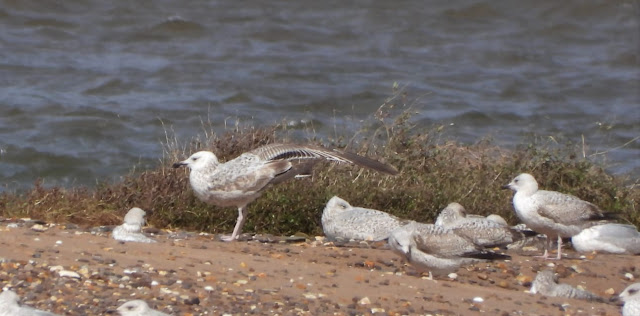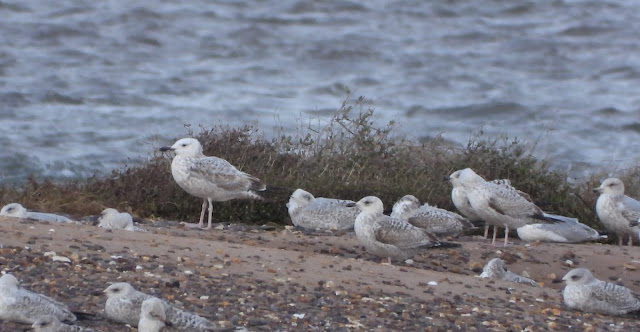A first winter Iceland Gull was a brief visitor to Finger Point mid morning, flying in from upriver, it circled around and joined over 160 Herring Gull on Finger Point. The recent increase in Herring Gull roosting on Finger Point is a welcome occurrence, but it may have come about due to the reduction in Great Black-backed Gull numbers using the Point. This species has globally declined by 48% since 1985, the loss of another bird today due to poultry flu, highlights the risk to this familiar species. The tortured antics of the dying bird were enough to cause all the other gulls to desert their roost.
Iceland Gull - both Lee Collins
Also in the estuary the two immature Spoonbill were present on the dropping tide with counts of 366 Oystercatcher, 76 Curlew, 59 Turnstone, 52 Dark-bellied Brent Geese, 28 Redshank, 21 Grey and four Ringed Plover, 13 Sanderling, five Greenshank, just two Dunlin and a Bar-tailed Godwit.
The Firecrest remains behind the Main Pond, with 11 Chiffchaff, four Wheatear and three Goldcrest also on site, along with at least five pairs of Stonechat and four singing Cirl Bunting. Offshore just 12 Great Crested Grebe present along with four Sandwich Tern, four Red-breasted Merganser, three Common Scoter and two Red-throated Diver.
No sign of any large swifts today, on or offsite, but frequent scanning revealed a light, often very high, mixed passage. Totals included five Rook, three Jackdaw, three Buzzard, two Stock Dove, a Sparrowhawk and a Raven along with single figure counts of Chaffinch, Goldfinch, Lesser Black-backed Gull, Linnet, Meadow Pipit and Skylark.
Iceland Gull & Finger Point high tide gull roost - David Flack
Wildlife News: Although chilly the bright start looked promising but the arrival of cloud cover and showers limited invertebrate activity and only provided a narrow window for flowering Sand Crocus. One or two Water Vole showed on the Main Pond swimming across the main channel.





%20280323.JPG)






%20250323.JPG)








%20140323.JPG)








%20070223.JPG)

